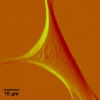On atomic force microscopy and the constitutive behavior of living cells
- PMID: 15322929
- PMCID: PMC1315312
- DOI: 10.1007/s10237-004-0051-x
On atomic force microscopy and the constitutive behavior of living cells
Abstract
Atomic force microscopy (AFM) is one of many new technologies available to study the mechanical properties and mechanobiological responses of living cells. Despite the widespread usage of this technology, there has been little attempt to develop new theoretical frameworks to interpret the associated data. Rather, most analyses rely on the classical Hertz solution for the indentation of an elastic half-space within the context of linearized elasticity. In contrast, we propose a fully nonlinear, constrained mixture model for adherent cells that allows one to account separately for the contributions of the three primary structural constituents of the cytoskeleton. Moreover, we extend a prior solution for a small indentation superimposed on a finite equibiaxial extension by incorporating in this mixture model for the special case of an initially random distribution of constituents (actin, intermediate filaments, and microtubules). We submit that this theoretical framework will allow an improved interpretation of indentation force-depth data from a sub-class of atomic force microscopy tests and will serve as an important analytical check for future finite element models. The latter will be necessary to exploit further the capabilities of both atomic force microscopy and nonlinear mixture theories for cell behavior.
Figures






Similar articles
-
Analysis of indentation: implications for measuring mechanical properties with atomic force microscopy.J Biomech Eng. 1999 Oct;121(5):462-71. doi: 10.1115/1.2835074. J Biomech Eng. 1999. PMID: 10529912
-
Finite element modeling of living cells for AFM indentation-based biomechanical characterization.Micron. 2019 Jan;116:108-115. doi: 10.1016/j.micron.2018.10.004. Epub 2018 Oct 14. Micron. 2019. PMID: 30366196
-
Biomechanical Heterogeneity of Living Cells: Comparison between Atomic Force Microscopy and Finite Element Simulation.Langmuir. 2019 Jun 11;35(23):7578-7587. doi: 10.1021/acs.langmuir.8b02211. Epub 2018 Oct 16. Langmuir. 2019. PMID: 30272980
-
Axisymmetric Contact Problem for a Flattened Cell: Contributions of Substrate Effect and Cell Thickness to the Determination of Viscoelastic Properties by Using AFM Indentation.Scanning. 2017 Dec 20;2017:8519539. doi: 10.1155/2017/8519539. eCollection 2017. Scanning. 2017. PMID: 29422981 Free PMC article. Review.
-
Atomic force microscopy in mechanobiology: measuring microelastic heterogeneity of living cells.Methods Mol Biol. 2011;736:303-29. doi: 10.1007/978-1-61779-105-5_19. Methods Mol Biol. 2011. PMID: 21660735 Review.
Cited by
-
A theoretical model for F-actin remodeling in vascular smooth muscle cells subjected to cyclic stretch.J Theor Biol. 2007 May 7;246(1):87-99. doi: 10.1016/j.jtbi.2006.11.015. Epub 2006 Dec 15. J Theor Biol. 2007. PMID: 17240401 Free PMC article.
-
A dynamic stochastic model of frequency-dependent stress fiber alignment induced by cyclic stretch.PLoS One. 2009;4(3):e4853. doi: 10.1371/journal.pone.0004853. Epub 2009 Mar 25. PLoS One. 2009. PMID: 19319193 Free PMC article.
-
Changes in the hyperelastic properties of endothelial cells induced by tumor necrosis factor-alpha.Biophys J. 2008 Apr 15;94(8):3273-85. doi: 10.1529/biophysj.106.099333. Epub 2008 Jan 16. Biophys J. 2008. PMID: 18199670 Free PMC article.
-
In silico stress fibre content affects peak strain in cytoplasm and nucleus but not in the membrane for uniaxial substrate stretch.Med Biol Eng Comput. 2021 Sep;59(9):1933-1944. doi: 10.1007/s11517-021-02393-z. Epub 2021 Aug 14. Med Biol Eng Comput. 2021. PMID: 34392447
-
Cellular mechanosensing of the biophysical microenvironment: A review of mathematical models of biophysical regulation of cell responses.Phys Life Rev. 2017 Dec;22-23:88-119. doi: 10.1016/j.plrev.2017.06.016. Epub 2017 Jun 21. Phys Life Rev. 2017. PMID: 28688729 Free PMC article. Review.
References
-
- None
- Alberts B, Johnson A, Lewis J, Raff M, Roberts K, Walter P (2002) Molecular biology of the cell. Garland Science, New York
-
- None
- Beatty MF, Usmani SA (1975) On the indentation of a highly elastic half-space. Q J Mech Appl Math 28:47–62
-
- None
- Briscoe BJ, Sebastian KS, Adams MJ (1994) The effect of indenter geometry on the elastic response to indentation. J Phys D Appl Phys 27:1156–1162
-
- {'text': '', 'ref_index': 1, 'ids': [{'type': 'PubMed', 'value': '2214714', 'is_inner': True, 'url': 'https://pubmed.ncbi.nlm.nih.gov/2214714/'}]}
- Brodland GW, Gordon R (1990) Intermediate filaments may prevent buckling of compressively loaded microtubules. ASME J Biomech Eng 112:319–321 - PubMed
-
- {'text': '', 'ref_index': 1, 'ids': [{'type': 'PubMed', 'value': '10609523', 'is_inner': True, 'url': 'https://pubmed.ncbi.nlm.nih.gov/10609523/'}]}
- Cheng Y, Hartemink CA, Hartwig JH, Dewey CF (2000) Three-dimensional reconstruction of the actin cytoskeleton from stereo images. J Biomech 33:105–113 - PubMed
Publication types
MeSH terms
Grants and funding
LinkOut - more resources
Full Text Sources
Miscellaneous
